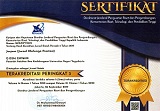STROKE RATE (SR) AND STROKE LENGTH (SL) FREESTYLE SWIMMER INDONESIAN STUDENT PARTICIPANTS POPNAS 2009
DOI:
https://doi.org/10.21831/jorpres.v8i2.10292Abstract
Purpose of this study to identify patterns of stroke rate (SR) and stroke length (SL) freestyle swimmer Indonesian student participants popnas 2009.
Subjectsdrawn from participants weekend sports student athletes nationwide pool of 2009 branches in Yogyakarta Special Region.The data retrieval performed 1 time for 4 days, namely in the afternoon during the final numbers, the first step taken pictures of each swimmer's time following the final number and then calculated the number of stokes rate and velocity.
Results indicate that the length of sl in both female athletes and men in the freestyle show curve and the same pattern, namely the shorter distances shorter renangan sl and the further distance the longer renangan sl but with different figures, the number of sr freestyle results shows the range 19.98 to male athletes and female athletes at 23:31. results from this study suggest that the number and length sl sr in the freestyle with different distances and curve have the same pattern.
Key words: stroke rate (SR) and stroke length (SL)
Downloads
How to Cite
Issue
Section
License
Authors who publish with this journal agree to the following terms:
- Authors retain copyright and grant the journal right of first publication with the work simultaneously licensed under a Creative Commons Attribution License that allows others to share the work with an acknowledgement of the work's authorship and initial publication in this journal.
- Authors are able to enter into separate, additional contractual arrangements for the non-exclusive distribution of the journal's published version of the work (e.g., post it to an institutional repository or publish it in a book), with an acknowledgement of its initial publication in this journal.
- Authors are permitted and encouraged to post their work online (e.g., in institutional repositories or on their website) prior to and during the submission process, as it can lead to productive exchanges, as well as earlier and greater citation of published work (See The Effect of Open Access).




